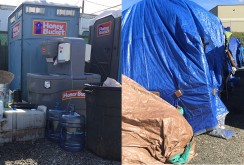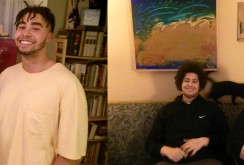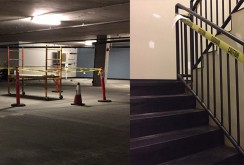
For years, Pete Soukus lived on top of the hill in Seattle’s wealthy Magnolia neighborhood that overlooks Interbay and Tent City 5. Pete still lives in Magnolia, but his new home now lies in the shadow of the hill, inside of Tent City 5. Until alcohol took over his life, Pete had a career in product management and supply-chain logistics, a home and a family. Then according to Pete, “I drank myself to the point of almost losing my life.”
Pete didn’t lose his life, but he lost his fiancé, his home and his job. He hasn’t seen his kids in years. He remembers spending one night hunkered down under a bush after drinking a bottle of hand sanitizer.
In the words of the immortal Janis Joplin, who sang Me and Bobby McGee, “Freedom is just another word for nothing left to lose.” Hitting the bottom might be a humbling experience, but there is a raw honesty that sets in when everything of material value has been stripped away.
Pete remembers a day, July 7th to be precise, when his despair exceeded anything he could manage and he was on the brink of suicide. He was in a ditch with a small black cat—who reminded him of his sweet cat Emma—he had lost with everything else. This cat came to him and sat on his lap and purred. He quit drinking for five days until July 12.
Through Sound Mental Health Institute (SMHI), he entered the Kitsap Recovery system and completed the program, but as soon as he got out on November 24, he drank again. On Dec 24, he had his last drink. He has stayed clean and sober for several months.
Pete talk about his life as a series of steps. The first step back into the community has been working at the Puget Sound Food Bank on 1st and Clay, where he takes his skills from his past life as a product manager, organizing the food supply so it can be distributed to the community.
Pete’s second step has been tied to becoming an EC (Executive Committee) for Tent City 5. The community votes for its five members of the EC. Pete is one of the five who works with his peers to help manage the camp and keep everyone safe. There are six shifts for the ECs and one of the five is always on watch 24/7. Pete describes how when a newcomer comes in, he helps get refuge from the street by giving him a sleeping bag and food and a place to rest.
Pete reassures those new to the camp, “We’ve all been homeless,” he says. “I understand. It’s okay. I know you can make it.”
By becoming part of Tent City 5, a person starts to grow. Pete acknowledges that this growing process is painful and it’s different for each person. “But you can’t grow in life without learning how to manage the pain,” he says. “It takes courage in taking responsibility for our own lives and buying into the community again.”
What’s important to Pete is the human contact and building community and trust for those who haven’t been able to trust while living out on the street or maybe they’ve never had a chance to trust at all…until now. Tent City 5 gives people a chance to function at a higher level and to live in a community where people look out for one another.
There are as many reasons why people become homeless as there are stories to be told in the Tent cities: illness coupled with lack of healthcare, lost job, trauma, mood disorders, mental illness, addictions are only a few reasons; there are many more. In Tent City 5, one person is dying from cancer and another has Multiple Sclerosis (MS). Sometimes life doles out lemons and they all lineup the wrong way. Without community support there can be a rapid descent into homelessness. Who’s to say it couldn’t happen to any one of us?
Like Pete said about his fellow residents, “Every person here has a story to tell as long as a book.”











